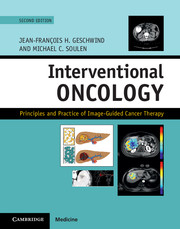Book contents
- Frontmatter
- Contents
- List of contributors
- Section I Principles of oncology
- Section II Principles of image-guided therapies
- 2 Principles of radiofrequency and microwave tumor ablation
- 3 Principles of irreversible electroporation
- 4 Principles of high-intensity focused ultrasound
- 5 Principles of tumor embolotherapy and chemoembolization
- 6 Principles of radioembolization
- 7 Principles of intra-arterial infusional chemotherapy in the treatment of liver metastases from colorectal cancer
- 8 Imaging in interventional oncology: Role of image guidance
- 9 Novel developments in MR assessment of treatment response after locoregional therapy
- Section III Organ-specific cancers – primary liver cancers
- Section IV Organ-specific cancers – liver metastases
- Section V Organ-specific cancers – extrahepatic biliary cancer
- Section VI Organ-specific cancers – renal cell carcinoma
- Section VII Organ-specific cancers – chest
- Section VIII Organ-specific cancers – musculoskeletal
- Section IX Organ-specific cancers – prostate
- Section X Specialized interventional techniques in cancer care
- Index
- References
2 - Principles of radiofrequency and microwave tumor ablation
from Section II - Principles of image-guided therapies
Published online by Cambridge University Press: 05 September 2016
- Frontmatter
- Contents
- List of contributors
- Section I Principles of oncology
- Section II Principles of image-guided therapies
- 2 Principles of radiofrequency and microwave tumor ablation
- 3 Principles of irreversible electroporation
- 4 Principles of high-intensity focused ultrasound
- 5 Principles of tumor embolotherapy and chemoembolization
- 6 Principles of radioembolization
- 7 Principles of intra-arterial infusional chemotherapy in the treatment of liver metastases from colorectal cancer
- 8 Imaging in interventional oncology: Role of image guidance
- 9 Novel developments in MR assessment of treatment response after locoregional therapy
- Section III Organ-specific cancers – primary liver cancers
- Section IV Organ-specific cancers – liver metastases
- Section V Organ-specific cancers – extrahepatic biliary cancer
- Section VI Organ-specific cancers – renal cell carcinoma
- Section VII Organ-specific cancers – chest
- Section VIII Organ-specific cancers – musculoskeletal
- Section IX Organ-specific cancers – prostate
- Section X Specialized interventional techniques in cancer care
- Index
- References
Summary
Key points
• Radiofrequency (RF) ablation and/or microwave ablation are viable alternatives for the treatment of many solid focal malignancies, especially in the non-surgical candidate.
• Benefits of image-guided, minimally invasive energy ablation include low morbidity and mortality, low cost, inclusion of non-surgical patients, and same-day discharge.
• The basic principles of RF and microwave ablation can be divided into three main elements, including: (1) biology of heating; (2) RF and microwave technology; and (3) operator expertise and technique.
• Successful treatment is obtained when balancing between complete tumor destruction and minimizing damage to surrounding normal parenchyma and adjacent structures.
• Widespread adoption of RF and microwave ablation will rely upon improving and increasing tumor ablation volume. Adjuvant therapies such as chemotherapeutics, antiangiogenics, embolization, and radiation hold great promise in this capacity.
Introduction
Image-guided, minimally invasive tumor ablation aims to eradicate or substantially destroy focal tumors by inducing irreversible cellular injury through the application of thermal and non-thermal energy or chemical injection. Ablative modalities can be divided into energy-based ablation and chemical ablation. While chemical ablation uses agents such as ethanol or acetic acid to induce coagulation necrosis and tumor ablation, energy-based ablative techniques destroy a tumor via thermal (heat or cold) or non-thermal techniques. Two examples of energy-based modalities, RF ablation and microwave ablation, are the principal topic of this chapter. These therapies, initially RF ablation and now, to an ever-increasing extent, microwave, have gained widespread attention in the medical community and have become broadly accepted as methods for treating focal malignancies in a wide range of tumor types and tissues. These include primary and secondary malignancies of the liver, kidney, lung, and bone. Given the multiplicity of treatment types, complexity of paradigms in oncology, and diverse application of energy-based ablation techniques, a thorough understanding of the basic principles and recent advances in RF and microwave ablation is a necessary prerequisite for their effective clinical use (Figure 2.1).
The ultimate goal of minimally invasive, energy-based tumor ablation for focal malignancies is to completely eradicate all viable malignant cells within the target tumor. Based upon tumor recurrence patterns and pathologic analyses in long-term studies in patients who have undergone surgical resection or ablation, there are often viable persistent microscopic tumor foci in a rim of apparently normal surrounding parenchymal tissue beyond the visible tumor margin.
- Type
- Chapter
- Information
- Interventional OncologyPrinciples and Practice of Image-Guided Cancer Therapy, pp. 3 - 12Publisher: Cambridge University PressPrint publication year: 2016
References
- 1
- Cited by



